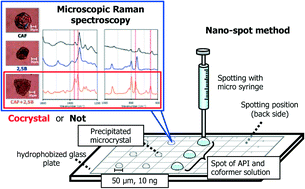Microanalysis of pharmaceutical cocrystals using a nano-spot method coupled with Raman spectroscopy†
Abstract
Recently, the formation of pharmaceutical cocrystals has attracted significant attention because it improves the physicochemical properties of active pharmaceutical ingredients (APIs). In this study, we developed a novel nano-spot method that can possibly reduce the API consumption for an exploring study of pharmaceutical cocrystals by using Raman spectroscopy. The study was performed as follows: (i) a small amount of the sample solution was deposited on the surface of a hydrophobized glass plate using a microsyringe, (ii) the droplet gradually shrank due to drying of the solvent, and a “microcrystal” was precipitated, and (iii) the molecular state of the microcrystal was evaluated by using Raman spectroscopy. By optimizing the hydrophobizing reagent and solvent for spotting samples, a fluorine-coating reagent and ethanol were determined to be the best combination for the nano-spot method. We used caffeine as a model API, and ten types of pharmaceutical ingredients were selected as cocrystal formers. To reduce the operation time, we used an automatic dispensing machine for nano-spotting. The resulting microcrystals were similar to the produced microcrystals manually dispensed out of the solution. Under the optimized conditions, characteristic Raman spectra were obtained from ca. 10 ng of microcrystals and were similar to previously reported results. The technique would be suitable for the early stage of new drug development in which the use of a candidate compound is strictly limited.


 Please wait while we load your content...
Please wait while we load your content...